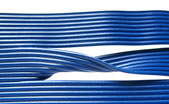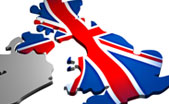Connecting the Internet of Things
With predictions of up to 50 billion internet-enabled devices by 2020, it is worth considering exactly how these devices will actually connect to the internet and to each other.
While some devices will inevitably be subject to fixed connections (cables, wires, etc.) the vast majority are likely to employ some form of wireless connection.
However, wireless spectrum is a finite resource. Given the projected explosion in connected devices how is it going to be possible to ensure that they can all be connected without completely swamping the wireless infrastructure?
What technologies will be used?
 As with the common-or-garden internet, the Internet of Things (IoT) needs to be viewed in a technology neutral way. There will not be one single protocol that will apply to the various different devices that will connect to the internet under this banner.
As with the common-or-garden internet, the Internet of Things (IoT) needs to be viewed in a technology neutral way. There will not be one single protocol that will apply to the various different devices that will connect to the internet under this banner.
Instead, device manufacturers, service providers and network operators will deploy a variety of technologies dependent upon the technical characteristics of their devices, their connection needs, their geographical and physical location and commercial issues.
The ways in which these new devices need to connect may be quite different from existing internet devices. While a phone or tablet may be continually connected for long periods of time or require a great deal of bandwidth (e.g. when a user is using their device to stream a movie), IoT devices (e.g. smart meters, monitoring devices in the home, etc.) may only need to connect for short periods and may only need to exchange very small amounts of data. While some may need a constant connection (e.g. instruments providing some element of remote monitoring) many such devices may only need to upload data once a day or even less frequently.
As mentioned above, the vast majority of devices are likely to be connected by means of wireless technologies.
Licensed Mobile Technologies
Some such devices will use existing 2G, 3G and 4G/LTE mobile frequencies. In the UK, these frequencies are already licensed exclusively to the mobile network operators so anyone looking to launch an IoT service using these frequencies, will need to do so in conjunction with the mobile networks to some degree.
The advantage of using mobile networks is that mobile data networks provide good coverage across most of the UK although there are obviously gaps in these networks where reception can prove more difficult – especially in more rural areas. With the roll-out of new 4G networks over the next few years and continued improvement of 3G networks, network coverage is likely to improve, although 100% coverage is unlikely to occur in practice.
Different frequencies used by mobile services have different characteristics which could lend themselves to being deployed for different types of devices – for example, lower frequency mobile frequencies (such as 800 MHz and 900 MHz) are typically regarded as being better for mobile broadband, especially for indoor and rural coverage, than those that use higher frequencies.
Mobile networks are, however, already prone to congestion and this position is likely to continue into the future, even with the roll-out of new 4G networks, as users become used to accessing applications and services requiring ever escalating levels of bandwidth (particularly video services) from their smartphones and tablets.
WiFi
 WiFi systems (typically operating in the 2.4GHz and 5.8GHz bands) are already popular in the home and within buildings and are now increasingly being implemented in many towns and cities so that you can get WiFi access virtually anywhere via a network of routers.
WiFi systems (typically operating in the 2.4GHz and 5.8GHz bands) are already popular in the home and within buildings and are now increasingly being implemented in many towns and cities so that you can get WiFi access virtually anywhere via a network of routers.
The concept has been so successful that "small cells" are now coming to the market as a complementary technology to work alongside next generation mobile and fixed networks. They are seen as a key technology to provide additional capacity in urban areas and to help reach out to rural areas where it may be uneconomic to install fibre networks or in which traditional mobile networks are not the optimal solution.
Unlike the mobile frequencies mentioned above, WiFi is licence exempt – i.e. you do not need to have a specific licence to use it. This means that it is potentially available to everyone, although you will ultimately face capacity issues if too many people try to use a cell at the same time (as with mobile).
'White Space' and other initiatives
While mobile and WiFi are already well established technologies using recognised frequency bands, the potential explosion in demand that will be caused by the deployment of IoT and Machine to Machine (M2M) technologies has led industry and governments to explore ways in which further bands of spectrum can be deployed for this purpose.
This is not an easy process as the vast majority of existing spectrum has already been allocated for specific uses. This process requires co-ordination at both a national and international level, meaning that for important changes intended to apply on an international basis it can take many years to achieve agreement.
One possible solution currently being explored in the UK and some other countries, is to use the gaps, or so-called "white spaces" that sit in the frequency band used to broadcast digital terrestrial TV. The white space frequencies vary by region but lie in chunks of spectrum between 470MHz and 790Mhz.
 The idea is that white space devices would access the spaces at times when they are vacant, by communicating their locations to a database designed to minimise the risk of interference with any existing users. The amount of white space available in the UK varies by location, the power level of devices and the point in the day at which they access spectrum.
The idea is that white space devices would access the spaces at times when they are vacant, by communicating their locations to a database designed to minimise the risk of interference with any existing users. The amount of white space available in the UK varies by location, the power level of devices and the point in the day at which they access spectrum.
White space is available for use on a wireless exempt basis, which again means that manufacturers could get devices to market relatively quickly and cost-effectively.
Ofcom is currently consulting on what they refer to as "co-existence" in these frequencies – i.e. how best to allow new white space services to exist alongside digital TV services without causing interference to either – and it is, therefore, anticipated that we should see wide-spread deployment of technologies in these areas soon.
Another key initiative in this area is the development of the so-called "Weightless standard" being developed in Cambridge for use of TV white space for IoT/M2M purposes. Designed as a sort of Bluetooth for M2M, the intention behind this standard is to enable the development and implementation of low cost, low power devices that enjoy ubiquitous coverage and require little or no configuration once they have been deployed in the field. While TV white space is initially being targeted, this standard could equally be deployed in other bands.
Conclusion
 While mobile and WiFi networks are likely to be key technologies for the IoT, it will ultimately be necessary to look to other technical solutions and frequency bands to ensure that the IoT is allowed to flourish. White space is just one example. This will ultimately require further co-operation between industry and government on an international basis, and it will be vital that future spectrum planning activities are designed to ensure that sufficient bandwidth can be made available to support a wide range of devices and technologies on a scale that will potentially dwarf what we are currently used to dealing with.
While mobile and WiFi networks are likely to be key technologies for the IoT, it will ultimately be necessary to look to other technical solutions and frequency bands to ensure that the IoT is allowed to flourish. White space is just one example. This will ultimately require further co-operation between industry and government on an international basis, and it will be vital that future spectrum planning activities are designed to ensure that sufficient bandwidth can be made available to support a wide range of devices and technologies on a scale that will potentially dwarf what we are currently used to dealing with.
If you have any questions on this article please contact us.

"While mobile and WiFi networks are likely to be key technologies for the IoT, it will ultimately be necessary to look to other technical and frequency bands."


